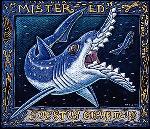

My interest in Paleozoic fish began with my finding the shark spine shown above. It belongs to the genus Ctenacanthus and is from the Minturn Formation, near McCoy, Colorado. For several years I have been studying a collection of chondrichthyan (sharks and relatives) spines and teeth from the Minturn Formation. Most of the specimens were found by Martin Lockley (University of Colorado at Denver) and Karen Houck (now at Eastern Kentucky University). I hope to publish a paper or two describing this collection. I gave a preliminary report at the Early Vertebrates/Lower Vertebrates Symposium at Northern Arizona University in Flagstaff in May, 2000. The abstract for this talk is given below. Please don't quote this, or the contents of the slides below without checking with me first, as I may have changed my mind about some of the conclusions.
Macroscopic chondrichthyan remains, including teeth, finspines, and dermal denticles, are reported from shallow-water carbonate and shale facies of the middle Pennsylvanian (late Atokan to Desmoinesian) Minturn Formation of Eagle County, Colorado. Previously reported taxa include Petalodus ohioensis Safford, "Cladodus" occidentalis Leidy (previously identified as Symmorium reniforme Cope), Lagarodus angustus (Romanovsky), Janassa sp., Deltodus sp., cf. Agassizodus variabilis (Newberry and Worthen), cf. Gilliodus peyeri Zangerl, Ctenacanthus sp., "Ctenacanthus" furcicarinatus Newberry, cf. Bythiacanthus siderius Leidy, and cf. Batacanthus sp. Newly identified taxa include Acondylacanthus sp., Petrodus sp., Peripristis semicircularis (Newberry and Worthen), Polyrhizodus sp., and Edestus sp. Most of the newly identified taxa have not previously been reported from the southern Rocky Mountain region. A tentative association of "Cladodus" occidentalis teeth with Ctenacanthus cf. C. buttersi St. John and Worthen finspines is suggested by the relative abundances of the taxa. The fauna is typical of carbonate facies and differs greatly from those found in Pennsylvanian black-shale facies of North America.
Click on the link below to download a PDF file of the slides for this talk. Please don't quote from them without checking with me first, as I may have changed some of my conclusions. The file is about 1.1 MB. Free software for reading PDF files is available from the Adobe website.
 Slides for Early Vertebrates Meeting (PDF file. 1.1 MB.)
Slides for Early Vertebrates Meeting (PDF file. 1.1 MB.)
![]() Back to Itano family home page
Back to Itano family home page